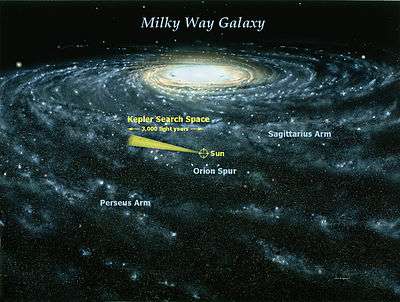ELODIE spectrograph
ELODIE was an echelle type spectrograph installed at the Observatoire de Haute-Provence 1.93m reflector in south-eastern France for the Northern Extrasolar Planet Search. Its optical instrumentation was developed by André Baranne from the Marseille Observatory. The purpose of this instrument was extrasolar planet detection by the radial velocity method. This instrument was also used for the M-Dwarf Programmes.
ELODIE first light was achieved in 1993. ELODIE was decommissioned in August 2006 and replaced in September 2006 by SOPHIE, a new instrument of the same type but with improved features.[1][2]
Characteristics
The electromagnetic spectrum wavelength range is 389.5 nm to 681.5 nm in a single exposure, split into 67 spectral orders. The instrument, which was located in a temperature-controlled room, was fed with optical fibers from the Cassegrain focus. One of the unique features of ELODIE was an integrated data reduction pipeline which fully reduces the spectra immediately after acquisition and allows the user to measure highly accurate radial velocities through cross-correlation with a numerical mask. This accuracy can reach ±7 m/s.
Over 34,000 spectra have been taken with this instrument so far, over 20,000 of which are publicly available through a dedicated on-line archive.[3] ELODIE was the result of a collaboration between the observatories of Haute-Provence, Geneva and Marseille. A publication describing the instrument appeared in Astronomy & Astrophysics Supplements.[4]
Discovered planets
The first extrasolar planet to be discovered orbiting a Sun-like star, 51 Pegasi b, was discovered in 1995 using this instrument.[5]. Michel Mayor and Didier Queloz received the Nobel Prize in Physics 2019 for this achievement. [6] Over twenty such planets have been found with ELODIE.
This instrument was also used to find a planet by the transit method.[7]
| Planet | Announced in | Ref |
|---|---|---|
| 51 Pegasi b | 1995 | [5] |
| Gliese 876 b | 1998 | [8] |
| 14 Herculis b | 1998 | [9] |
| HD 209458 b | 1999 | [7] |
See also
- CORALIE spectrograph is a similar instrument used for the Survey for Southern Extra-solar Planets
- List of extrasolar planets
References
- The ELODIE-SOPHIE Archive in the Virtual Observatory, S. Ilovaisky, Ph. Prugniel, C. Soubiran, M. Koleva, and H. Le Coroller, in Astronomical spectroscopy and the Virtual Observatory, Madrid (Spain), March 21–23, 2007, Madrid, 2007.
- A user's guide to Elodie archive data products, Elodie archive, Observatoire de Haute Provence. Accessed on line June 15, 2008.
- The ELODIE archive. Accessed on line June 15, 2008.
- ELODIE: A spectrograph for accurate radial velocity measurements, A. Baranne et al., Astronomy and Astrophysics Supplement 119 (October 1996), pp.373–390. Bibcode: 1996A&AS..119..373B
- Mayor; Queloz, Didier (1995). "A Jupiter-mass companion to a solar-type star". Nature. 378 (6555): 355–359. Bibcode:1995Natur.378..355M. doi:10.1038/378355a0.
- "The Nobel Prize in Physics 2019". Nobel Media AB. Retrieved 8 October 2019.
- Queloz; et al. (2000). "Detection of a spectroscopic transit by the planet orbiting the star HD209458". Astronomy and Astrophysics Letters. 359: L13–L17. arXiv:astro-ph/0006213. Bibcode:2000A&A...359L..13Q.
- Delfosse, X.; et al. (1998). "The closest extrasolar planet. A giant planet around the M4 dwarf GL 876". Astronomy and Astrophysics. 338: L67–L70. arXiv:astro-ph/9808026. Bibcode:1998A&A...338L..67D.
- Naef; Mayor, M.; Beuzit, J. L.; Perrier, C.; Queloz, D.; Sivan, J. P.; Udry, S. (2004). "The ELODIE survey for northern extra-solar planets. III. Three planetary candidates detected with ELODIE" (PDF). Astronomy and Astrophysics. 414 (1): 351–359. arXiv:astro-ph/0310261. Bibcode:2004A&A...414..351N. doi:10.1051/0004-6361:20034091.
External links
- (in English) The ELODIE Archive

